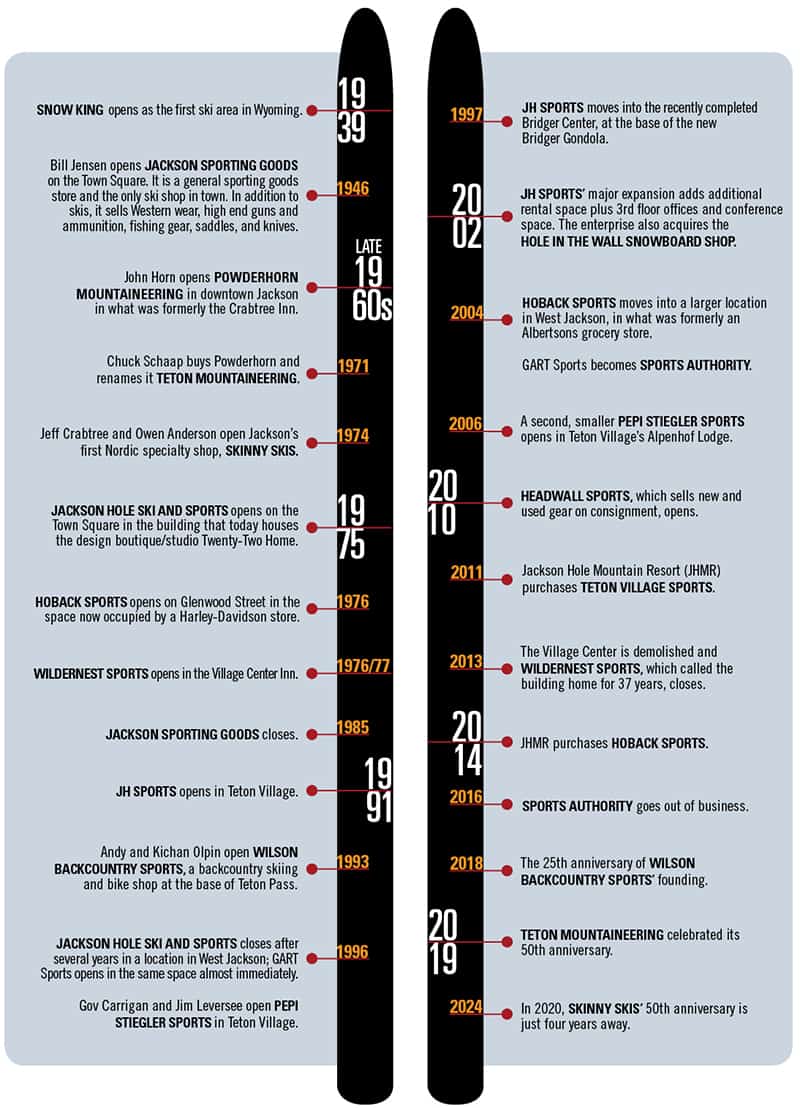Read The
Current Issue
Ski Hard, Work Harder.
Owning a ski shop isn’t always sunshine and powder, but it’s still a pretty awesome job.
By Leslie Hittmeier // photography by bradly j. boner
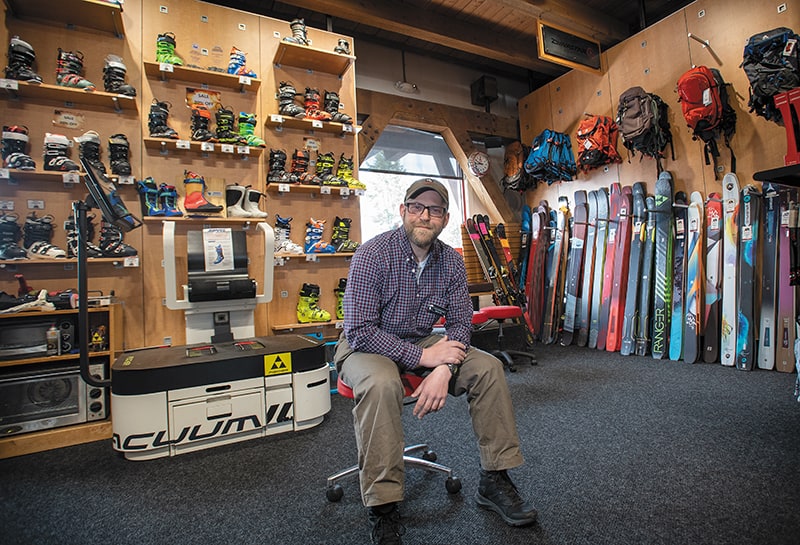
Larry Hartenstein started at JH Sports as the retail supervisor in 2000. He’s been the shop’s hardgoods buyer since 2002 and its general manager since 2011. “Life is too short to have a corporate job—and I get a ski break every day!” he says.
IN 1965 BILL Ashley opened Teton Village Sports (TVS), the first ski shop in Teton Village. It was the first winter of lift-served skiing at what was then called Jackson Hole Ski Area at Teton Village. If you walked into TVS, you’d find Bogner stretch pants, Lange boots (the first-ever plastic, as opposed to leather, ski boots), and skis more than six feet long. Ashley and crew measured the right ski length for customers by having them stand up and straighten their arms above their heads. The right ski would stop at their wrist crease.
“There was no grooming equipment or snow making equipment on the mountain in those years,” says Mike Wardell, who bought his first pair of plastic Lange boots from Ashley at TVS and became a part-owner of TVS from 1972 to 1987. “It would snow and you could still find powder two weeks later. From a ski business point of view, [we were] completely dependent on if it snowed or not. In those days in the month of January, there was nobody skiing except locals on the weekends. There’d be times where they’d hold a tram car for 30 to 45 minutes before they could get a dozen people to take to the top.”
In downtown Jackson in the late 1960s, a self-described “dirtbag climber” named Chuck Schaap unexpectedly found himself at the helm of Powderhorn Mountaineering, which sold climbing and backcountry ski equipment and clothing. “I was hanging around a lot because I was a climber and the manager asked me to run the store while he went on vacation,” Schaap says. “He said he would be gone for two weeks. I didn’t see him until 40 years later, when he dropped in to say hello.”
In 1971, the 29-year-old Schaap bought the business from the owner, John Horn, who wanted to pursue his outdoor clothing line, also named Powderhorn Mountaineering, rather than work in retail. As soon as Powderhorn Mountaineering (the store) was his, Schaap changed its name to Teton Mountaineering and began figuring out how to make a living from it. Back then, Jackson Hole was not the booming outdoor recreation mecca it is today—fewer than 5,000 people lived in Teton County, the federal government classified the valley as economically depressed for nine months of the year, a ski season at the resort in Teton Village saw around 75,000 skier days, and the backcountry ski industry was just a seed buried deep in the snowpack, even if locals were already making turns on Teton Pass (on wooden cross-country equipment and leather boots).
“Starting out we probably just had one or two models of skis,” says Schaap, now 77 and, as of this past fall, no longer TM’s owner. Rex Hong, who has been an employee or manager at the store since 1981, bought the business from Schapp.
Basically, Teton Mountaineering sold what was available at the time: floppy boots that Schaap says were comparable to bedroom slippers and narrow wooden skis made by Fischer and now-extinct brands like Bonna. The skis had no sidecut whatsoever; they were completely straight from one end to the other. Still, Teton Mountaineering survived. It celebrated its 50th anniversary in 2019. And skiing—at resorts and in the backcountry—has exploded.
IN 2017–18, THE most recent full season for which data is available, SnowSports Industries America (SIA) reports that 24.3 million people participated in winter sports, including alpine skiing, snowboarding, cross-country skiing, alpine touring and split boarding, and snowshoeing. (The data SIA used came from the NPD Group, which collects and interprets data for more than 20 different industries.) Of these participants, 14.7 million were skiers and 7.1 million were snowboarders. As big as 24.3 million sounds, it is actually a decrease of 1.5 percent from the 2016–17 season. Still, SIA reports that in 2018 people spent more than $1 billion ($1,096,863,380, to be exact) on snow sports gear, apparel, and accessories.
Despite the overall decrease in winter sports participation, the popularity of backcountry skiing and snowboarding is on the rise. In 2018 there were 703,000 backcountry skiers and 682,000 backcountry snowboarders aged 18 or older. Backcountry skiers spent $8,159,556 on gear specifically designed to allow them to ski terrain inaccessible by lifts (this figure does not include apparel).
Skinny Skis, originally a Nordic skiing specialty shop, followed Powderhorn/Teton Mountaineering in downtown Jackson, and is another outlier of longevity. Skinny Skis opened in a 500-square-foot space on Deloney Avenue in 1974. Today it still claims that same space and has expanded into what were other retail spaces on either side of the original store.
Unlike TVS in the Village and Teton Mountaineering, Skinny Skis wasn’t concerned with downhill or backcountry skiing. Its co-founder, Jeff Crabtree, was the Nordic ski team coach and realized there was no place to obtain good equipment in town. Crabtree convinced family friend Owen Anderson to help him open a shop dedicated to cross-country skiing equipment and clothing. From 1974 until 1977 Skinny Skis was only open seasonally, from October through March. Crabtree spent summers working at the Colter Bay Marina in Grand Teton National Park.
Phil Leeds took Andersen’s place as one of Skinny Skis’ co-owners in 1977 and remains so today. He remembers the early days well. “Ski-wise we probably had only two or three brands,” he says. “And we carried a few Norwegian ski sweaters and some wool knickers. That was about the extent of it.” (Leeds now co-owns the store with Scott O’Brien, who joined in 2014; the store has expanded beyond just Nordic gear.)
The community of Wilson is an obvious spot for a shop dedicated to backcountry skiing because of its location at the base of Teton Pass, the most popular backcountry skiing locale in the area. Wilson Backcountry Sports opened there in 1993. At that time backcountry skiing was still in its infancy, but Andy Olpin, who opened (and still owns) Wilson Backcountry Sports with his wife Kichan, saw the growth potential and took a leap of faith.
“Even back then the parking lots on the pass were full on the weekends,” Olpin says. “The base of the pass is a great place to have a shop, especially for the locals who live here so they don’t deal with the traffic in [Jackson].”
The Bridger-Teton National Forest (BTNF) and Friends of Pathways estimates between 40,000 and 50,000 skiers and snowboarders skied or rode on Teton Pass last season, which ran from November 2018 to June 2019. On December 18, the busiest day of last season, 611 skiers and riders were tallied. Teton Pass Ambassador Jay Pistono, who is employed by the Bridger-Teton National Forest to talk with recreationists about backcountry safety and responsible use on Teton Pass, says about 100,000 ski runs were made on the pass over the course of last winter.
AS MUCH AS skiing, snowboarding, and ski touring have grown since the first ski shop opened in Jackson Hole, owning and running a ski shop here isn’t all face shots and fresh tracks, or even a guaranteed success. Present and future challenges include E-commerce, the rising cost of housing, the fact that so many locals here manage to get reduced professional pricing on gear (known as “proform”), the fine art of inventory selection, and climate change. When the Olpins opened Wilson Backcountry Sports, Internet shopping didn’t exist. Wilson Backcountry Sports has managed to persevere, but Wildernest Sports, Jackson Hole Sporting Goods, and Pepi Stiegler Sports are all ski shops that have come and gone, and Jackson Hole Mountain Resort (JHMR) bought Teton Village Sports in 2014.
The Olpins are happy when their shop breaks even. “Selling skis is hard,” Andy says. “Everybody [in Jackson] has hookups for proforms and many people assume you can get it cheaper online.”
Skinny Skis and Teton Mountaineering carried nearly everything that was available in their niches when each opened. “Now, Patagonia has 20 colors and 45 different styles of the same pants,” Schaap says. Choosing and buying inventory can make or break a ski shop’s bottom line. “If you misjudge a color or size style and it doesn’t sell it will never sell. In my early days, if you had a parka that didn’t sell, it would come back the next year in the same colors and sizes and you would just sell it then. Nowadays, if it’s six months out of date, it’s a piece of junk.”
Hong, TM’s new owner (but manager since 1984), says “We are a clothing store these days. Seventy percent of our sales are clothing. [In 1984] it was the reverse—we even sold kayaks. The outdoor clothing market was just developing back then: Patagonia was a brand new company. The selection and amount of clothing available since then has exploded. And now it goes beyond climbers and skiers. You don’t need to be going to do anything extreme to have a warm jacket that stays dry.”
The diversity of outdoor clothing is not the only big change in the last 45 years. Those edgeless, wooden skis that Teton Mountaineering and Skinny Skis carried, and the alpine skis that TVS sold, have evolved. Bases are wider, lengths shorter, and weights lighter. Skis are more shapely—hourglass-shaped skis debuted in the 1980s, and the ’90s saw the birth of twin-tip skis. Over that same time period telemark skiing, in which skiers’ heels are not clamped down and turns are initiated by a leg lunge, lowered the barrier to entry for backcountry skiing. (Because a telemark binding does not lock a skier’s heel to a ski, it allows backcountry skiers to ski uphill with the aid of climbing skins affixed to the bases of their skis.) In the late 1990s, alpine touring (AT) gear began to appear, although backcountry skiers generally still preferred telemark gear because the new AT equipment was so much heavier. By the mid-2000s though, AT gear had made huge advances that improved performance while shedding weight. Today you might still find some skiers who telemark, but the discipline has gone way downhill in terms of participation.
IN 2000 LARRY Hartenstein started working as the retail supervisor at JH Sports, the newest of all ski shops in Teton Village (it opened in 1991 and moved into its present location in the Bridger Center in 1997). He’s been the ski shop’s hardgoods buyer since 2002 and its general manager since 2011. “When I first got here we had three lines of alpine skis; now we are up to eight lines,” he says. Hartenstein estimates that about 80 percent of people who ski or snowboard at Jackson Hole Mountain Resort come into JH Sports, located at the base of three JHMR lifts and adjacent to the ski-in/ski-out Four Seasons Resort.
A large part of the reason JH Sports has been able to grow its selection of skis, as well as the rest of its inventory, is that JHMR’s number of skier days, a metric used to measure the number of skiers at a resort on a given day or season, has steadily increased. Last winter was the resort’s biggest ever in terms of skier days: 715,100. This was an almost 13 percent increase over the resort’s prior record for skier days, 634,500 during the 2017–18 season.
For all the work and challenge it is owning and/or managing a ski shop, everyone interviewed for this story agreed that it’s worth it. The Olpins and Schaap say they have relationships and friendships with employees and within the Jackson Hole community they wouldn’t have without their businesses.
“We have some employees who have been here 15 and 20 years, they are like our family now,” Andy says. “And we have some customers who we have watched their kids grow up and go to college. We are just lucky that way.”
Hartenstein, who started working in ski shops when he was in college and who skied 147 days last season, says, “Some of my dearest friends have come from working in a ski shop and in this very small industry that I am a part of. I truly enjoy the deep relationships I have built with guests from all over the world; providing them with the best service is paramount to my personal and commercial successes.”
Still, as much as relationships mean to owners and managers of valley ski shops, consider Hartenstein’s final words on why his job is awesome: “Life is too short to have a corporate job—and I get a ski break every day!” JH
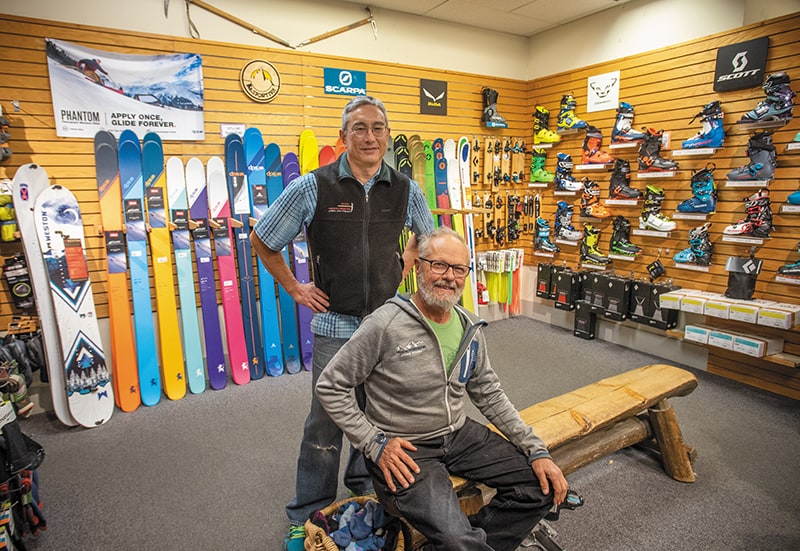
Chuck Schaap, seated, founded Teton Mountaineering in 1971 and recently sold the business to his long-time manager, Rex Hong, who has worked in that position at the shop since 1984.
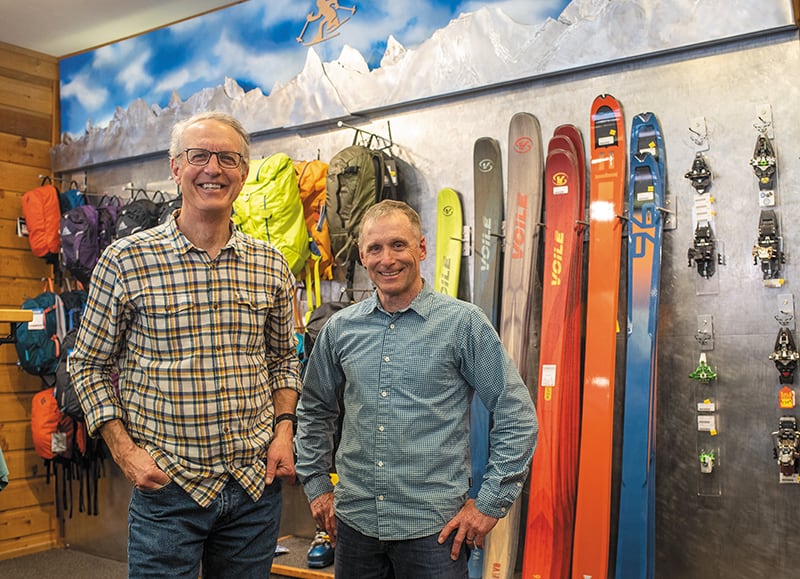
Skinny Skis was founded as a seasonal Nordic shop in 1974. In 1977, Phil Leeds (left) became a co-owner, and the shop began staying open all year. Scott O’Brien (right) bought into the business in 2014.
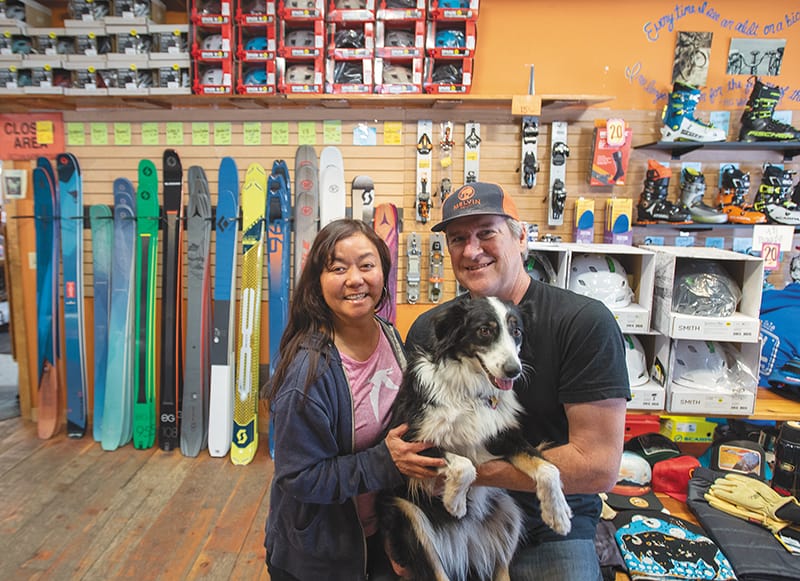
Andy and Kichan Olpin opened Wilson Backcountry Sports in 1993 at the base of Teton Pass. At that time backcountry skiing was still in its infancy, but the Olpins saw the growth potential and took a leap of faith.
